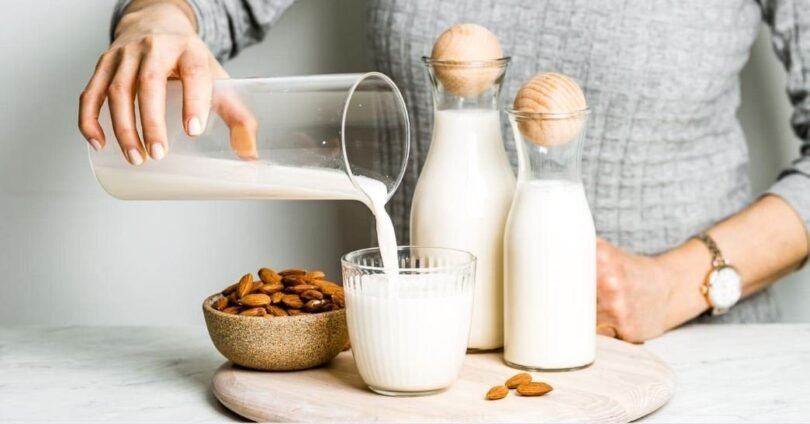Almond milk is a well-liked nut milk that is dairy-free and vegan-friendly and is a nutritious addition to any smoothie or shake. Almond milk is rich in numerous vitamins and nutrients, low in calories and sugar, and free of cholesterol and saturated fat. Almond milk prepared at home is fresher, better tasting, and free of flavorings and fillers. To make it, simply a few basic ingredients are required. So if you are curious to know how to make almond milk at home, proceed to read this article. Thus, with little effort, prepare your own fresh and healthy almond milk and enjoy it.
Why opt for homemade almond milk?
Making almond milk at home ensures its purity and freshness. Hence, it is always preferable than one from the store. It won’t contain any fillers, preservatives, or additives. To make it, you will only use organic or best-quality almonds. You will be aware of the water’s source. Like other nuts, almonds quickly become rancid. You can be sure that you won’t use rancid almonds to make this milk when you make it at home.
What Are The Health Benefits Of Almond Milk?
The health benefits of drinking almond milk is given below:
- As almond milk is dairy-free, it doesn’t contain lactose or casein, which can upset the digestion of up to 75% of people worldwide.
- One cup of homemade almond milk may contain up to 8% of your recommended daily intake of calcium and 6% of your recommended daily intake of iron due to the nutrient-rich almonds.
- Almond milk can provide up to 6 grams per serving, assuming that all of the almonds’ nutrients are distributed into the homemade milk. (Approximately equal to 1 ounce of almonds.)
How Should Almond Milk Be Used?
Making almond milk a part of your morning is the simplest way to include it into your daily routine. Pour it into your cereals or soups or serve it straight up as a drink. In addition, a significant majority of individuals add it to their tea and coffee. Your morning smoothie is a terrific option to use almond milk as well. Simply prepare almond milk by blending almonds with water first, then blending in your preferred fruits.
Good Read: Quinoa: What Is It? Nutrition Facts, Health Benefits, Types & Many More
How To Make Almond Milk?
You will definitely adore how simple this recipe is. How to do it is as follows:
Ingredients:
- 1 cup raw almonds, soaked either for 1-2 hours in extremely hot water or overnight in cool water.
- 5 cups of filtered water.
- 1 pinch sea salt.
- 2 whole dates(optional / pitted / use your preferred sweetener / skip for unsweetened).
- 1 teaspoon vanilla extract (optional/ or use sub 1 vanilla bean, scraped per 1 teaspoon extract/ skip for plain).
- 2 tablespoons cocoa powder (optional/ for chocolate milk).
- 1/2 cup of berries(optional/ for berry milk).
Instructions:
- Almonds that have been soaked, water, salt, and any additional ingredients (optional), should all be added to a high-speed blender and blend until creamy and smooth. To get the most out of your almonds, let it run for at least a minute or two.
- To strain, use a thin dish towel or a nut milk bag. Simply place a clean dish towel over a mixing bowl, pour in the almond milk, collect the corners carefully, and raise up. Squeeze until all the liquid is extracted. Discard the pulp or keep it and use it in baked goods.
- Refrigerate milk after pouring it into a jar or covered bottle. Will last for up to 4-5 days, although it tastes best when it’s fresh. It tends to separate, so give it a good shake before drinking.
Nutrition(1 of 10 servings)
Serving: 1 half-cup serving, Calories: 31, Carbohydrates: 1.2 g, Protein: 1.1 g, Fat: 2.7 g, Saturated Fat: 0.2 g, Polyunsaturated Fat: 0.7 g, Monounsaturated Fat: 1.7 g, Trans Fat: 0 g, Cholesterol: 0 mg, Sodium: 4 mg, Potassium: 40 mg, Fiber: 0.7 g, Sugar: 0.2 g, Vitamin A: 0 IU, Vitamin C: 0 mg, Calcium: 10 mg, Iron: 0.2 mg.
How Long Does It Last?
How effectively you sterilize your equipment, the freshness of your ingredients, and the temperature of your fridge will all affect how long it lasts. Homemade almond milk lasts about 4-5 days on average. You must only prepare as much homemade almond milk as you feel you will use in the next few days since it only keeps for a short while in the refrigerator. If it goes sour before then, ensure that you thoroughly sterilize your equipment before using it by putting it through the dishwasher or boiling your jars (make sure they aren’t too cold when you do this or they can break). Additionally, keep in mind to soak your almonds overnight in the refrigerator instead of at room temperature.
What Is To Be Done With The Leftover Almond Pulp?
Almond pulp is actually really useful. The leftover almond pulp, also known as almond meal, should be spread on a baking tray and baked for 2 to 3 hours at 200°F (100°C) until it becomes dry. Once that is done, you may use it as a topping for yogurt, chia pudding, homemade granola, as well as other baking recipes.
Frequently Asked Questions(FAQs)
1. How Long Should The Almonds Soak Before Making Almond Milk?
For the greatest results, let the almonds soak overnight.
2. How Long Does This Almond Milk Have A Shelf Life?
Three to four days are the shelf life of this almond milk. But make sure to store it in the fridge.
3. Can I Bake Cakes With This Almond Milk?
Yes, you may use this almond milk to make cakes as well.






